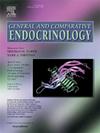评估圈养木鸭(Aix sponsa)急性应激反应的变化。
IF 1.7
3区 医学
Q3 ENDOCRINOLOGY & METABOLISM
引用次数: 0
摘要
在野生、自由生活的鸟类中,急性应激反应与身体状况有关,并与有限能量资源的分配有关。然而,圈养环境中个体的身体状况与急性应激反应之间的关系不太清楚,因为圈养环境中能量资源丰富且容易获得。我们评估了个体身体状况的变化(反映为体重)与成年圈养木鸭(Aix sponsa)的急性应激反应的关系,这些木鸭是从野外收集的蛋中孵化出来的,并在繁殖季节内外自由喂养。我们测定了28只鸭的血浆皮质酮(CORT)水平,采集时间分别为春秋季、繁殖季节和非繁殖季节,采集时间分别为捕获后3 分钟和捕获后10、30和60 分钟。每只鸟的身体状况测量在早春记录一次。在广义线性混合模型(GLMM)中分析了体重、年龄和一年中的时间(繁殖季节与非繁殖季节)对总分泌量和最大分泌量的影响。没有发现年龄、体重和总CORT或最高CORT之间的关系。总CORT在繁殖季节内外的反应有显著差异(p本文章由计算机程序翻译,如有差异,请以英文原文为准。
Evaluating variation in acute stress response in captive Wood Ducks (Aix sponsa)
Acute stress response has been linked to body condition and associated with the allocation of finite energy resources in wild, free-living birds. However, the relationship between the body condition of individuals and the acute stress response is less clear for birds kept in captive settings, where energy resources are abundant and readily available. We evaluated how individual variation in body condition, reflected as body mass, relates to the acute stress response in adult captive Wood Ducks (Aix sponsa) hatched from eggs collected in the wild and reared in captivity while birds were fed ad libitum, in and out of the breeding season. We determined plasma corticosterone (CORT) levels from blood collected within 3 min of capture and at 10, 30, and 60 min post-capture from 28 ducks during spring and fall, in and out of breeding season. Body condition measurements were recorded once for each bird in early spring. The effects of body mass, age, and time of year (in vs. out of breeding season) on total and maximum CORT secreted were analyzed in Generalized Linear Mixed Models (GLMM). No relationships between age, body mass, and total or maximum CORT were found. There was a significant difference in response in and out of the breeding season for total CORT (p < 0.01) and maximum CORT (p < 0.001), with a higher response during the breeding season. Measures of individual responses for total (p = 0.001) and maximum CORT (p < 0.01) were consistent across seasons. Baseline CORT levels were consistently low, with 53.6 % and 78.6 % of the samples below the detection limit during and outside of breeding season, respectively. These results highlight differences in baseline CORT maintenance compared to studies on wild Wood Ducks, potentially relating to environmental differences such as unlimited food supply and protection from predators in captivity. Additionally, we found that captive birds maintain seasonal variation in acute stress response, which reflects some trends found in wild birds, although more research across multiple seasons is warranted. We also found that some captive Wood Ducks continue to increase CORT secretion at the end of the 60 min handling period, indicating that longer handling times may reveal differences in total CORT secreted. Further investigation should be done to assess the costs and benefits of variation in body condition in terms of coping ability across life stages.
求助全文
通过发布文献求助,成功后即可免费获取论文全文。
去求助
来源期刊

General and comparative endocrinology
医学-内分泌学与代谢
CiteScore
5.60
自引率
7.40%
发文量
120
审稿时长
2 months
期刊介绍:
General and Comparative Endocrinology publishes articles concerned with the many complexities of vertebrate and invertebrate endocrine systems at the sub-molecular, molecular, cellular and organismal levels of analysis.
 求助内容:
求助内容: 应助结果提醒方式:
应助结果提醒方式:


